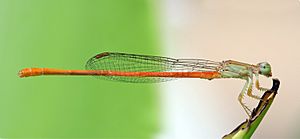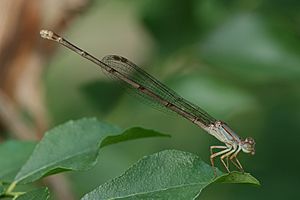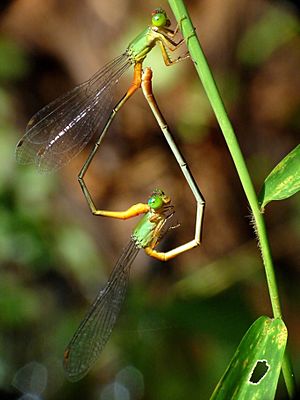Ceriagrion facts for kids
Quick facts for kids Ceriagrion |
|
|---|---|
 |
|
| Male Ceriagrion glabrum | |
 |
|
| Female Ceriagrion glabrum | |
| Scientific classification |
|
| Kingdom: | Animalia |
| Phylum: | Arthropoda |
| Class: | Insecta |
| Order: | Odonata |
| Suborder: | Zygoptera |
| Family: | Coenagrionidae |
| Genus: | Ceriagrion Selys, 1876 |
Ceriagrion is a group of beautiful insects called damselflies. They are part of the Coenagrionidae family. These damselflies are usually small to medium in size. They often have bright, eye-catching colors! You can find Ceriagrion damselflies all over the Old World. This includes places like Africa, Asia, and Australia.
Contents
Discovering Ceriagrion Damselflies
Ceriagrion damselflies are fascinating creatures. They are known for their slender bodies and colorful appearance. Many species have bright orange, red, or blue colors. These colors help them stand out in their natural homes.
Where Do Ceriagrion Damselflies Live?
Ceriagrion damselflies love to live near water. You can often spot them around ponds, slow-moving rivers, and marshy areas. They need water to lay their eggs. Their young, called nymphs, live underwater. These damselflies are found across a huge area. This includes many countries in Africa, Asia, and Australia.
What Do Damselflies Eat?
Damselflies are expert hunters. They mainly eat small insects like mosquitoes and flies. They catch their prey while flying. This makes them very helpful in controlling insect populations. Their diet helps keep the ecosystem balanced.
Damselflies vs. Dragonflies: What's the Difference?
It's easy to confuse damselflies with dragonflies. But there are a few simple ways to tell them apart. When a damselfly rests, it usually holds its wings together over its back. Dragonflies, however, often hold their wings out to the sides. Damselflies also tend to be smaller and have thinner bodies than dragonflies.
Different Kinds of Ceriagrion Damselflies
The Ceriagrion group has many different species. Each species has its own unique look and habits. Scientists have identified many types of Ceriagrion damselflies. Here are some of the known species:
- Ceriagrion aeruginosum (Brauer, 1869) – Redtail
- Ceriagrion annulatum Fraser, 1955
- Ceriagrion annulosum Lieftinck, 1934
- Ceriagrion auranticum Fraser, 1922
- Ceriagrion auritum Fraser, 1951
- Ceriagrion azureum (Selys, 1891)
- Ceriagrion bakeri Fraser, 1941
- Ceriagrion batjanum Asahina, 1967
- Ceriagrion bellona Laidlaw, 1915
- Ceriagrion calamineum Lieftinck, 1951
- Ceriagrion cerinorubellum (Brauer, 1865)
- Ceriagrion chaoi Schmidt, 1964
- Ceriagrion citrinum Campion, 1914
- Ceriagrion coeruleum Laidlaw, 1919
- Ceriagrion corallinum Campion, 1914
- Ceriagrion coromandelianum (Fabricius, 1798)
- Ceriagrion fallax Ris, 1914
- Ceriagrion georgifreyi Schmidt, 1953 – Turkish Red Damsel
- Ceriagrion glabrum (Burmeister, 1839) – Common Orange, Common Pond-damsel, Common Citril
- Ceriagrion hamoni Fraser, 1955
- Ceriagrion hoogerwerfi Lieftinck, 1940
- Ceriagrion ignitum Campion, 1914
- Ceriagrion inaequale Lieftinck, 1932
- Ceriagrion indochinense Asahina, 1967
- Ceriagrion katamborae Pinhey, 1961
- Ceriagrion kordofanicum Ris, 1924
- Ceriagrion lieftincki Asahina, 1967
- Ceriagrion madagazureum Fraser, 1949
- Ceriagrion malaisei Schmidt, 1964
- Ceriagrion melanurum Selys, 1876
- Ceriagrion moorei Longfield, 1952
- Ceriagrion mourae Pinhey, 1969
- Ceriagrion nigroflavum Fraser, 1933
- Ceriagrion nigrolineatum Schmidt, 1951
- Ceriagrion nipponicum Asahina, 1967
- Ceriagrion oblongulum Schmidt, 1951
- Ceriagrion olivaceum Laidlaw, 1914
- Ceriagrion pallidum Fraser, 1933
- Ceriagrion praetermissum Lieftinck, 1929
- Ceriagrion rubellocerinum Fraser, 1947
- Ceriagrion rubiae Laidlaw, 1916
- Ceriagrion sakejii Pinhey, 1963
- Ceriagrion sinense Asahina, 1967
- Ceriagrion suave Ris, 1921 – Suave Citril
- Ceriagrion tenellum (de Villers, 1789) – Small Red Damselfly
- Ceriagrion tricrenaticeps Legrand, 1984
- Ceriagrion varians (Martin, 1908)
- Ceriagrion whellani Longfield, 1952


